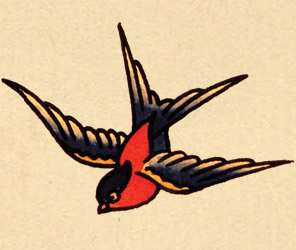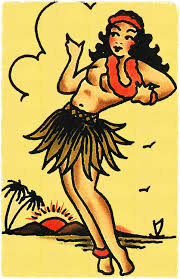Navy Life
Sailor Tattoos
Sailors have traditionally favored tattooing of their bodies. Tattoos were common, for the most part, only among sailors in the early half of the 20th century. This tradition goes back to the 1700s when Captain James Cooke made his now-famous voyage to the South Pacific Tahitians and decided to get souvenirs of their “tatau” with his men. Over time, these men traveling between the Pacific and the United States was what helped introduce tattooing to our culture.
While there were undoubtably variations in meaning depending on time/region, here are a few of the most classic tattoos and what they’re believed to mean:

- A dragon indicates a sailor has served in China.
- Golden Dragon means the sailor has crossed the International Date Line.
- Anchors: The original meaning, that you've sailed across the Atlantic. Crossed anchors on the web between the thumb and index finger for a bosns mate.
- Harpoon refers to a member of the fishing fleet.
- Rope around the wrist refers to a sailor is or was a deckhand.
- Sparrow: for every 5000 nautical miles traveled.
- Swallow: Initially, Sailors got swallows before they went out to sea, because swallows always come home; nowadays, one swallow means you've sailed 5,000 miles, and two means 10,000. Two swallows, one on each hand means "these fists fly" ie. the sailor likes to fight. Swallows on the chest would lift the soul to heaven if the sailor perishes.
- Rooster and pig: on the ankles are to prevent a sailor from drowning. The pig and the rooster: are tattooed on either the calves or the top of the feet, to prevent a sailor from drowning. These animals were originally carried on most ships in wooden crates. When a ship goes down these crates would float and then catch currents and wash ashore with the other debris from the ship, making the pigs and roosters often the only souls to survive a shipwreck. A tattoo of a pig on the left knee: it was a symbol for safety at sea; it was a symbol of protection for sailors. A rooster on the right foot: because it never loses a fight; it symbolizes the fights sailors went while at sea. They were the symbol of fertility; to make sure sailors would always have ham and eggs, and never go hungry.
- Turtle standing on its back legs (shellback): it meant that the sailor had crossed the equator and had been initiated into King Neptune's Court.
- King Neptune: it was acquired after you crossed the Equator.
- Palm Trees: Royal Navy tattoos of palm trees were made to represent the Mediterranean cruises in WWII. Many US sailors would normally have a tattoo of a palm tree or hula girl from Hawaii.
- HOLD and FAST: were tattooed on and across the knuckles. It is believed that the tattoos would keep them from falling overboard or dropping a line.
- Full rigged ship: tattoo made after sailing around Cape Horn.
- Two stars: a sailor who can perform celestial navigation .
- Guns or crossed cannon: tattoo normally acquired by military naval service.
- Crosses on the soles of one's feet: tattoo acquired to ward off hungry sharks.
- Nautical star or Compass rose: tattoo that symbolize and was used to help sailors to always find their way home.
- Dagger through a Rose: symbolize a willingness to fight and kill even something as fragile as a rose.
- Many sailors also got pornographic images: so that they would always have them with them, and sometimes so they would not be drafted by the military service in their countries.
- Jolly Roger: A symbol for getting in trouble and going to Captain's Defaulters.
- Full-Rigged Ship: Means that the sailor has sailed around Cape Horn. Back in the day, when ships were actually powered by wind, you were also allowed to get a blue star on your ear, and if you did it five times, you could get one on your other ear.
- Hula Girl: Means that you've been to Hawaii.
- Crosses on the soles of one's feet is maent to ward off hungry sharks.
Sailor Jerry Tattoos
Norman Collins, better known as Sailor Jerry, was a prolific tattoo artist for sailors. During the Second World War in Honolulu, Hawaii, the red-light district was ablaze with sailors and soldiers about to ship off, and in the very center of this was Collins. His skill and prolific work helped make tattoos an art form in America rather than merely a permanent souvenir for sailors.
Classic Sailor Jerry Tattoos
 Hula girl
Hula girl- Snakes
- Wildcats
- The "aloha" monkey
- Birds of prey
- Swallows
- Motor heads and pistons
- Nautical stars
- Weapons, such as guns, and knives
- Dice
